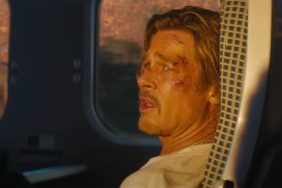Parkour creator David Belle does not speak English, though he does in Brick Mansions, the American remake of District B13. For an interview, he had a translator with him. Fred Cassidy told me what Belle was saying, and I considered it a victory whenever I heard Belle go on at length. That meant I hit on something right no matter what the translation. B13 was the first movie to focus on Parkour as the predominant martial art. In the American version, Belle reprises his role in Brick as a resident of a ghetto fighting drug dealers, who teams up with an undercover cop (Paul Walker) to stop a bomb from going off. Brick Mansions opens Friday.
CraveOnline: When we’re doing Parkour, should we scream “Parkour!” while we’re doing it?
David Belle: No. No, actually Parkour is more of an expression through the body. Of course, if you’re happy, you can express that but it’s more the internal scream. It’s an internal scream.
Did you see when “The Office” did Parkour and screamed it?
[Not translated] I like, I like.
They weren’t really doing Parkour though, were they?
No, they were having fun.
Was there a time when Luc Besson did not want to remake District B13?
I never heard that Luc didn’t want to make a remake. I think the time it took to happen was because they were looking for the right actor to play the role with me, but I never heard that rumor.
Was it unusual doing some of the same scenes in English?
It allowed me to have another dimension, or another take to the scenes because if I look at B13, which was actually my first movie, I can be very critical about it looking at scenes. The wish is usually, when you see that, I wish I had another chance to do it. Actually, when the American remake came about, it was like all right, I have a chance to improve some things.
Which scenes do you think you got better?
That’s up to the public to decide if they’re better or not, but I had a lot of pleasure to play and work and create these new scenes.
With Paul in Cyril Rafaelli’s role, was it unusual doing those scenes with a different actor?
It’s an interesting question because with Cyril we knew each other a lot better. We knew each other well, and yet in the film there was less chemistry. Paul, who I didn’t really know that well starting the film, there was actually a lot of connection and chemistry and that you can see in the film. It really helped my acting as well.
There’s great choreography in the films, but when you’re doing Parkour in real life you can only see so far ahead. How do you decide where you can jump, what spaces you can fit through, basically how do you do choreography on the fly?
Parkour is really a practice of getting to know yourself, what you’re able to do, what are your limits. As you train, you start knowing what you can do. So you start developing the confidence of knowing so when you’re seeing something, you’re always one step ahead. While you’re jumping one thing you’re looking at what the next move can be. There’s a constant analysis that is going on and what appears to be fluid is actually something that is step by step. It’s really about knowing yourself, knowing your limits and knowing what you’re capable of doing and having the confidence to do it.
So it’s mind and body working together?
Completely.
Then to do choreography for a movie, is that actually slowing Parkour down?
No, if the choreography goes in the direction of what Parkour would naturally do in the action. It’s really up to the director to find the musical aspect of the Parkour. Parkour is not just linear. There are moments that are intense and some that are lesser, so you have to move from one to another and that becomes the musicality of Parkour. There will be moments that we like to create that are memorable and someone will say, “Oh, remember that moment when someone did this or that?” We like to create that, but the choreography is you know where point A starts and you know where it ends. The choreography is what brings you from one to the other.
I don’t practice Parkour but I like to run, and I’m only 36 but I’m already having trouble where I can’t run as far or as often as I used to. Can you give me any advice to get my strength and stamina back?
Bruce Lee said we are what we devote ourselves to doing. We shouldn’t force ourselves to do something that really is just painful to us. If there is a discrepancy between what we are doing or putting our bodies through and then what our minds are telling us, you really have to look at yourself and the most essential part of it is the pleasure aspect. You have to like what you’re doing and what you’re training for.
If you see in sports at a super high level, people get hurt or have injuries when there isn’t that pleasure, the true pleasure of the sport, when they’re tired or demoralized or they’re not quite focused. That’s when people hurt themselves or injure themselves. The essential ingredient is really doing something for yourself. Sometimes your body is telling you to go in another direction. Sometimes it’s asking you to maybe find something else, but ultimately if you are doing something for somebody else who’s asking you to do it, it really has to come from inside and that way you can maintain the pleasure and then your body goes with it.
Will there be a third B13 film?
Why not? We’ll see if there’s a story that would warrant another film. Of course, as an actor I would like to explore other things, but why not? If there’s a phone call that comes and it’s viable, why not?
Fred Topel is a staff writer at CraveOnline and the man behind Best Episode Ever and The Shelf Space Awards. Follow him on Twitter at @FredTopel.









